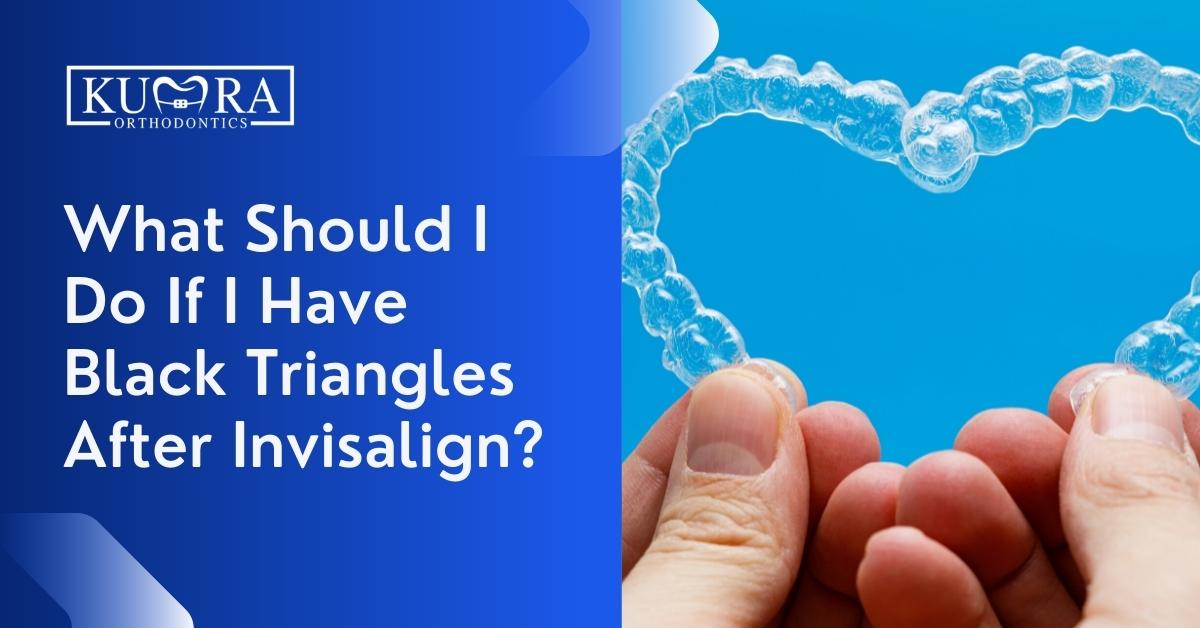Are you trying to figure out how to get rid of the black triangles that appear on your teeth after your Invisalign treatment? Your dentist can offer you several treatments to fix gaps in your teeth caused by gum recession. If you practice proper oral hygiene and visit the dentist regularly, you can avoid getting black triangles on your teeth.
However, if they create a cosmetic issue for you, you may require aesthetic treatments such as dental bonding, veneers, Invisalign, or a dermal filler to be put to that specific area of your mouth. The optimal treatment will depend on the severity of your gum recession and the dimensions of your black triangles.
What are Black Triangles?
In the world of dentistry, those little black triangles are referred to as gingival embrasures. These spaces develop between your teeth due to the gums in certain parts of your mouth receding. This typically occurs due to teeth that are misaligned, receding gums, or bone loss in the jawbone.
Although there is no guarantee that this will result in oral health problems, most people do not want this to be visible when they smile. They believe that it gives the impression that they do not care about the condition of their teeth, despite the fact that they do. It’s a given that people would believe they appear stressed out, unwell, aged, or like they haven’t cared for themselves in a long time.
Needing an orthodontic appointment?
Visit Kumra Orthodontics Washington, DC or Kumra Orthodontics Stafford, VA, and request an appointment with us!
Treatment for Black Triangles after Invisalign
Contrary to popular perception, orthodontic treatment, such as braces or Invisalign, does not cause black triangles. Treatment with orthodontics does not result in the development of black triangles; rather, it merely reveals them.
Braces and Invisalign
To lessen the visibility of the black triangles, your orthodontist may suggest that you undergo treatment with braces or Invisalign. The treatment consists of exerting direct pressure on particular teeth to coax them into moving into their correct alignment. When the teeth are moved and aligned, the black triangles can be efficiently removed.
Interproximal Reduction (IPR)
Orthodontists with a high level of expertise are the only people qualified to execute a procedure called interproximal reduction, which is used to close black triangles. The procedure is carried out manually, utilizing strips of diamond-coated flexible material that are worked back and forth between the teeth of the patient. A very small portion of the tooth enamel is removed, and this makes it possible for your teeth to be moved into closer proximity to one another. As a result, there will be fewer spaces and black triangles for your gum to fill in between your teeth.
What Causes Black Triangles?
Black triangles can appear on a person’s teeth for two different reasons: the geometry of the teeth themselves and the shape and size of the gum tissues that are found in the spaces between the teeth.
When a person’s teeth have a triangular shape, the tip of the tooth is wider than the area where it meets the gums. When you put two triangles next to each other, as you might expect, there will be a space between them at the top, which is the point where the two portions that are thinner than the others are adjacent to one another. This results in a gap, which can be seen as a black triangle when the darkness of the mouth is exposed.
Another factor to consider is the gum tissue of the individual. When we are younger, the spaces between our teeth are typically completely filled by our gums, which are taller and more expansive than they are as adults.
When the person grins, the only thing that is visible is their teeth and the gums in between them. But as we get older, the height of our gum tissue gradually declines, and we start to see triangular spaces where the teeth enter the gums. This is called a gingival recession. Even if a person has perfectly straight teeth and healthy gums, this might still happen to them.
Black triangles can be problematic for a number of reasons, including the fact that they have an unattractive appearance and the fact that they can trap food particles, both of which can contribute to tooth decay and gum disease.
Can Invisalign Cause Black Triangles?
Invisalign treatment is merely highlighting a lack of gum tissue that was always present and causing problems.
If you don’t practice proper oral hygiene, Invisalign and other orthodontic treatments might cause black triangles to appear on your teeth. This could result in a slight recession of the gums between your teeth. Suppose you maintain proper dental hygiene during your treatment with Invisalign or any other orthodontic method. In that case, it is quite unlikely that your Invisalign was the origin of the black triangles on your teeth.
However, as a result of the exposure to a lack of gum tissue brought about by orthodontic treatment, patients frequently report the appearance of black triangles. The roots of your teeth are now spaced more apart than they used to be. This is the case regardless of whether you are dealing with crowded or rotated teeth.
Gum tissue previously compressed between your teeth now has room to expand laterally, but it is possible that it will not be tall enough to fill the space completely. This typical problem arises when there is insufficient space between a person’s teeth for the gum tissue to develop normally.
Can Black Triangles be Prevented?
You won’t always be able to steer clear of the black triangles. Some gapping between your teeth is very normal and serves a purpose that can make it easier to clean them. If, on the other hand, there is a significant amount of space, you can lessen it by sticking to a rigorous oral hygiene practice.
If you have black triangles, it is essential that you adhere to a strict oral routine that includes flossing, brushing your teeth carefully, using mouthwash, and going to all of your dental cleaning appointments. Your gums will remain healthy due to these activities since they will avoid inflammation and bone loss around the teeth. It is extremely vital to visit your dentist consistently for them to monitor the health of your gums and teeth.
Read More: Is Invisalign Treatment Effective in Closing Tooth Gaps?
Consult Kumra Orthodontics to learn more about black triangle teeth Invisalign
If you are one of the many people who have experienced black triangles after straightening your teeth, don’t worry! This problem is easily solved by a visit to an orthodontist in Washington, DC like Kumra Orthodontics. We can help you understand why this happens and determine your best treatment plan. Contact us today to schedule a consultation and start reversing those unsightly black triangles!



